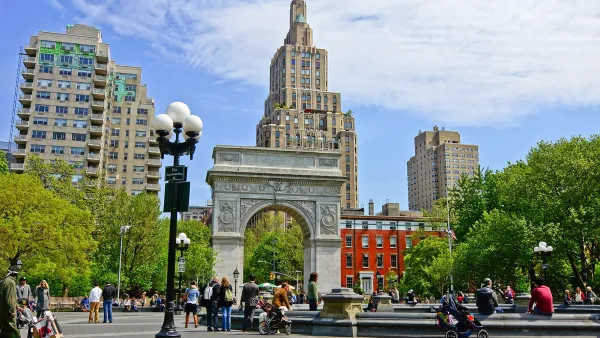In the aftermath of the Boston Marathon bombings, Eric Jaffe explores how cash-strapped cities will handle terrorism. "The short answer is public surveillance cameras. The long answer is smarter public surveillance cameras."
Jaffe reports from the New York Ideas festival, where NYPD Commissioner Ray Kelly explained how New York City has managed to maintain vigilent in combating terrorism despite having 6,000 less officers than it did a decade ago. "[A]n intricate system of cameras and license-plate readers," which covers Lower Manhattan and is being expanded to midtown and other "vulnerable" parts of the city, has been integral to their efforts.
"Part of what makes this strategy so efficient, despite a reduction in the size of the police force, is that cameras are handling more of the workload on their own," says Jaffe. "Analytics enable the cameras to see something and say something, if you will: they can determine if a package has been left in a particular spot for a long period of time, for instance, and track back through files to find a person wearing a certain color shirt."
However, as Sean Gallagher explains in Ars Technica, technology (and facial recognition software specifically) clearly failed in the search for the Boston bombing suspects. "Under the best circumstances, facial recognition can be extremely accurate, returning the right person as a potential match more than 99 percent of the time with ideal conditions," he says. "But to get that level of accuracy almost always requires some skilled guidance from humans, plus some up-front work to get a good image." Let's just hope those skilled humans aren't being furloughed when they're needed.
FULL STORY: How Cash-Strapped Cities Will Handle Terrorism

National Parks Layoffs Will Cause Communities to Lose Billions
Thousands of essential park workers were laid off this week, just before the busy spring break season.

Retro-silient?: America’s First “Eco-burb,” The Woodlands Turns 50
A master-planned community north of Houston offers lessons on green infrastructure and resilient design, but falls short of its founder’s lofty affordability and walkability goals.

Delivering for America Plan Will Downgrade Mail Service in at Least 49.5 Percent of Zip Codes
Republican and Democrat lawmakers criticize the plan for its disproportionate negative impact on rural communities.

Test News Post 1
This is a summary

Test News Headline 46
Test for the image on the front page.

Balancing Bombs and Butterflies: How the National Guard Protects a Rare Species
The National Guard at Fort Indiantown Gap uses GIS technology and land management strategies to balance military training with conservation efforts, ensuring the survival of the rare eastern regal fritillary butterfly.
Urban Design for Planners 1: Software Tools
This six-course series explores essential urban design concepts using open source software and equips planners with the tools they need to participate fully in the urban design process.
Planning for Universal Design
Learn the tools for implementing Universal Design in planning regulations.
EMC Planning Group, Inc.
Planetizen
Planetizen
Mpact (formerly Rail~Volution)
Great Falls Development Authority, Inc.
HUDs Office of Policy Development and Research
NYU Wagner Graduate School of Public Service




























